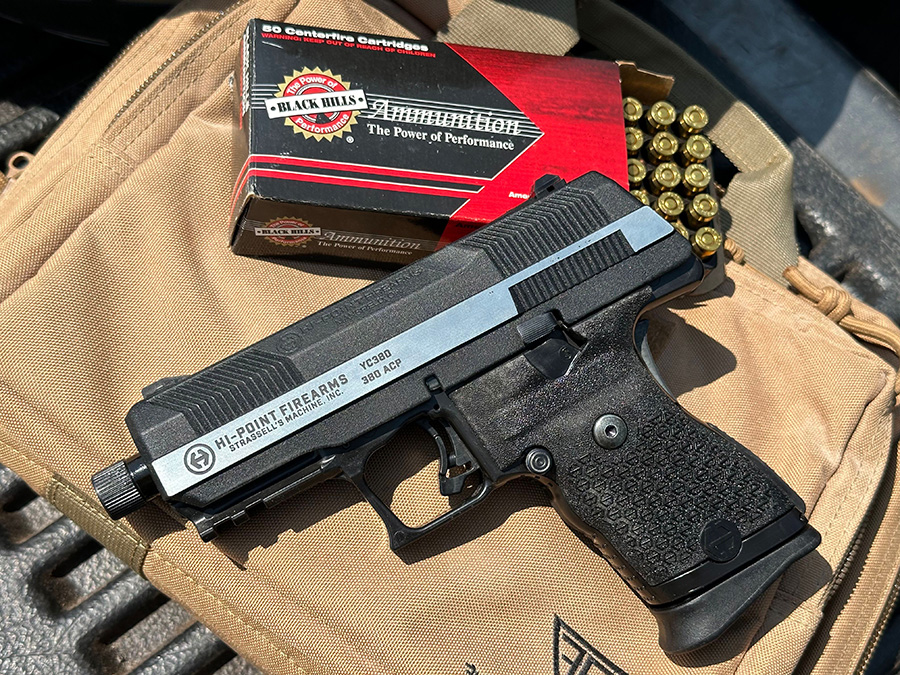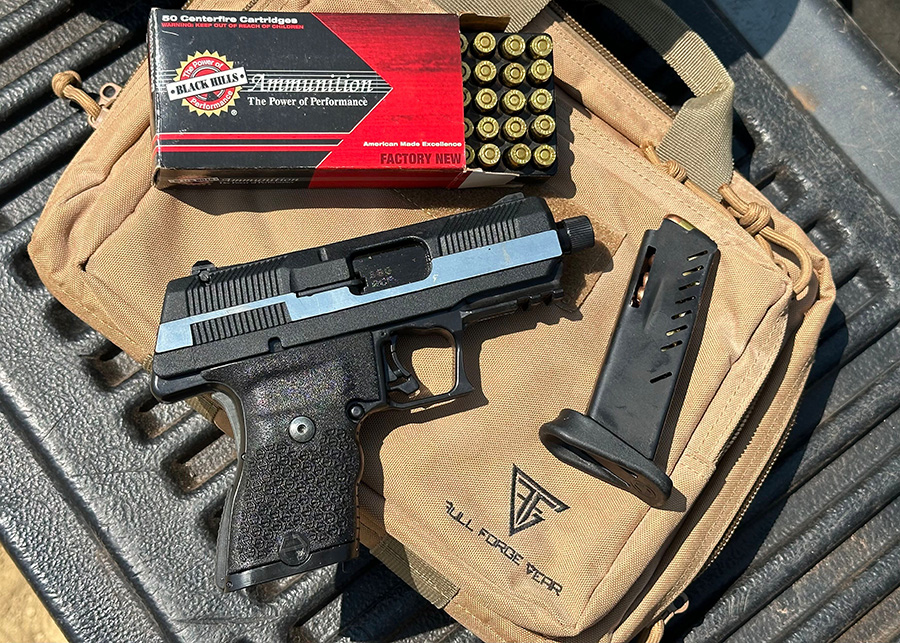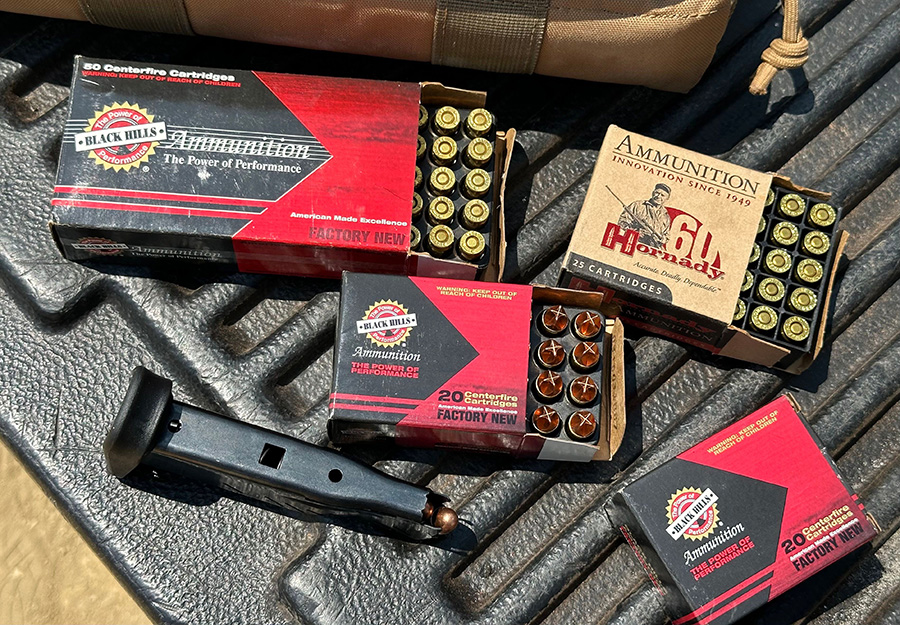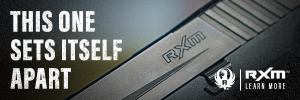
Allow me a moment, if you will. Back when I was a young man, if you wanted a “price point” or “inexpensive” semi-automatic handgun, you either bought a Raven, a Lorcin, or a Jennings in either .22 LR or .25 ACP. The .22 LR models were about as reliable as the weather. If you were ever able to fire a full magazine without a stoppage, you remembered that day like the day you found $100 in a parking lot. To their credit, the Raven .25 autos actually ran with FMJ ammo (which is really all we ever bought to shoot through them anyway).
Sure, I would rather not get shot at all than to get shot with a .22 or a .25, but all things considered, I would rather that my attacker at least realize that they have been injured before stabbing or shooting me to death. It’s generally accepted today that defensive handguns should be in .380 ACP at a minimum.
Additionally, even when the aforementioned tiny handguns did cycle, they were still barely big enough to control with one hand, let alone two. Even the .22s were snappy and the slides were so small that there wasn’t much to grab onto. When the frequent stoppages occurred, you could forget about using the tap-rack to get them back in the fight.
Hi-Point YC380
Last year, after much anticipation and typical internet rancor, Hi-Point Firearms released the YC9, also known as the “Yeet Cannon”, that name being the product of a Name the New Gun Contest (be careful what you ask for). As the .380 ACP round is for all intents and purposes a shorter version of the 9x19mm NATO (the .380 Automatic Colt Pistol cartridge is 9x17mm) it made perfect sense to release the new pistol as a YC380 and that’s exactly what has happened.

The new YC380 is nearly indistinguishable from the YC9 with the exception of the markings on the guns. They look the same, feel the same, weigh the same, but shoot different calibers.
When compared to the older Hi-Point .380 pistol, the YC380 has a redesigned slide with forward and rear cocking serrations and a new shape. The polymer frame also has unique textured grip panels and a rubber backstrap. Above the back strap is a grip safety that you might not even notice if someone didn’t point it out to you.
Hi-Point pistols have always used a fixed barrel and blowback action. That remains unchanged. From the factory, the YC380 comes with a threaded barrel that uses the American standard ½×28 TPI pattern. Atop the slide you’ll find the typical Hi-Point sights, subdued red in the rear and yellow in the front.
The new magazine is a 10-round version using a tapered double-stack design. The polymer floor plate looks very similar to other modern pistols and has the common finger rest. Each YC380 ships with one magazine. Additional mags can be purchased directly from Hi-Point. Speaking of magazines, like all Hi-Point firearms, the pistol includes a magazine disconnect safety.
Why .380 ACP?
For the longest time, when we thought of .380 ACP, we thought of tiny, sub-compact pocket pistols. Like the .22 and .25 version, the tiny .380s were snappy, notoriously unreliable unless you wanted to pay around $1000, and didn’t give the shooter much to hang onto.
Many, many moons ago, when we still killed trees and smeared colored ink on them, I reviewed the CF380 pistol from Hi-Point, the original .380 ACP gun from the company. While preparing the magazine article, I spoke to the folks at Hi-Point and they informed me that they first built the CF380 for a friend of the designer who had arthritis. The man’s condition was such that even mild 9x19mm ammo was too much. The Hi-Point pistol in .380 ACP, however, was a gun he could handle. For personal defense, centerfire .380 is a far superior choice to something like a .22 LR pistol.
There’s definitely a positive and realistic reason to put the .380 cartridge in a full-sized gun. Recoil is very manageable while there’s enough frame to be gripped with two hands for stability and the slide is large enough to grab and operate.

Range Time
For range time, in addition to the pistol, I had two magazines and. 380 ACP ammunition from Black Hills and Hornady. Also, before I left for the range I lubed the pistol’s action with Froglube.
As for the specific loads, from Black Hills Ammunitions I used their 100 grain FMJ, their 90 grain JHP (both subsonic) and the light and fast 60 grain HoneyBadger which is listed at 1150 FPS by the maker. From Hornady I had their 90 grain XTP load and a small amount of their 90 grain FTX or Critical Defense load. Both Hornady rounds are listed by the maker as having a velocity of 1000 FPS out of the muzzle.
Such was my desire to deliver this review to you that I endured temperatures in the mid-90’s on two July days in order to test and evaluate the YC380 from Hi-Point. As is my typical routine, I loaded the available magazines to capacity and performed some two-handed slowfire to see where the rounds were hitting. At 7 yards, all rounds grouped easily inside of the thoracic triangle on the cardboard target. From 15 yards I had no trouble hitting the steel ½ silhouette target.
As you would expect, the recoil of the pistol is easily managed during single-hand right and single-handed left shooting. I ran some rapid fire drills on steel and cardboard. During my time on the range with the YC380, I put somewhere between 250 and 275 rounds of .380 ACP ammunition through the gun. The pistol fed the Jacketed Hollow Point ammunition just as well as it did the FMJ. The unique HoneyBadger supersonic rounds were 100 percent reliable in the gun.
During two days of range time, I think I had to tap-rack two or three times to fix a stoppage. I marked the magazines as “1” and “2” to tell them apart. After each tap/rack I took note of the magazine number and #2 was always the culprit. The roll stamp on #2 showed that it was made during a different production run before #1 was made. That wasn’t catastrophic by any means, but when you review guns, you take note of small details.

If you have never fired a Hi-Point pistol, the experience will likely be a bit different than what you are used to. The barrel on Hi-Point pistols is affixed to the frame and doesn’t move or tilt during recoil. The straight blowback recoil os more like your favorite .22 LR pistol.
Fixed Income and New Shooters
Okay, so you don’t like the way the Hi-Point looks. Cool. Beauty is in the eye of the beholder, said someone named Margaret Hungerford. Maybe you listened to people on the internet or people at the gun shop who told you the Hi-Points don’t run. As to that assertion, as a person with twenty plus years of shooting them, I can attest that’s pure caca de toro.
Regardless of your cognitive dissonance regarding the Yeet Cannon, I would ask, do people with limited income or new shooters who aren’t ready to drop $1000 on guns and accessories deserve a pistol that runs in a caliber that could be used for home/personal defense? Or should they just have to wait until they can save up enough money to buy your favorite handgun?
Hi-Point YC380
Caliber: .380 ACP
Barrel length: 4.12″ Standard
Barrel length: 3.53″ Non-threaded
Weight: 34.2 oz. Standard
Capacity: 10-round mag standard
Overall length: 7.6″ (threaded barrel)
Rear Sights: Fully-adjustable & Red Dot Ready
Finish: Black powder coat
Frame: Standard 1913 accessory rail
Front Sights: Replaceable (Compatible with Glock®) front sights
MSRP: $215
Paul G. Markel is a combat decorated United States Marine veteran. He is also the founder of Student the Gun University and has been teaching Small Arms & Tactics to military personnel, police officers, and citizens for over three decades.


Interesting HiPoint is moving to threaded barrels, I wonder if this will result in an up-tick of plumbing supply silencers being mass-produced in the ‘hood…
I just came here to say “Yeet Cannon.”
Yeah, no way I would trust my life, or the lives of my family, to one of those things.
If you are on a budget, save your money for another week and get a Taurus G3c or G2c
If someone could wait an extra week, they could look into intermittent fasting and have enough extra cash to buy a Ruger Security 380. (You don’t need three meals per day – save your money.) They’re going for $260. Lighter, 1.5x capacity, better sights, and probably better pretty much everything else. Having a threaded barrel on a rock bottom priced pistol is odd.
Now that I am anxiously awaiting ATF to approve my Form 4s that I just submitted, I am deciding how I can use the forthcoming suppressors since none of my handguns have threaded barrels. One easy answer: I buy aftermarket threaded handgun barrels. My initial investigation suggests, however, that I can buy an entire Hi-Point handgun for about the same price (or possibly even less than) some aftermarket threaded barrels. This has me seriously thinking which way to go.
One of my primary use cases is neighbor-friendly (e.g. quiet) plinking. And when it comes to plinking for leisure purposes, shooting a Hi-Point handgun could be as relaxing and fun as shooting a much more expensive platform. Furthermore, if I end up plinking a LOT, a few thousand rounds of plinking could cause a failure on any handgun platform–and Hi-Point fixes their handguns forever at zero cost whereas other manufacturers often charge around $200 to repair them.
Decisions, decisions.
Oh, and I almost forgot to mention another significant use case for suppressors: home defense. In that regard Hi-Point firearms have a reputation for being extremely reliable assuming that you take reasonable care of them. If reliability is of utmost importance and you don’t care about size, weight, nor concealability (since we are talking about home defense), why not use a Hi-Point? Add the fact that cops would confiscate your firearm for potential charges and evidence purposes if you defended yourself in your home and a Hi-Point makes even more sense. (Would you rather that cops take your $900 super-duper pistol into evidence where they may scratch it up, allow it to rust, and possibly even break it? Or would you rather that cops take your $180 Hi-Point the same may happen?)
Congrats on your application, did you use E-File?
You should get your approval in short days…
Geoff PR,
Yes, I went the e-File route using the Silencer Shop kiosk at my local gun store. And I created a single-item trust for each suppressor. The beauty of a single-item trust is that I can add trustworthy family members and friends to the trust if I desire to do so in a fairly simple process.
I filed a week ago. Prior to my filing, ATF processing times for single-item trusts was averaging around two months. And because this is my first filing ever, my local gun store thinks that it will take ATF even longer to process mine. On the plus side, though, ATF may process mine much faster than two months because I submitted two at the same time and ATF is prioritizing “batch jobs” of multiple submissions. Time will tell.
I think it would be kind of amusing if ATF approves my filings and issues my tax stamps before any of my firearm barrels can actually use them!
Geoff PR,
I checked my e-mail history. I received an e-mail from ATF stating that my tax stamp submissions were “in progress” 6 days ago. Now I get to hurry up and wait.